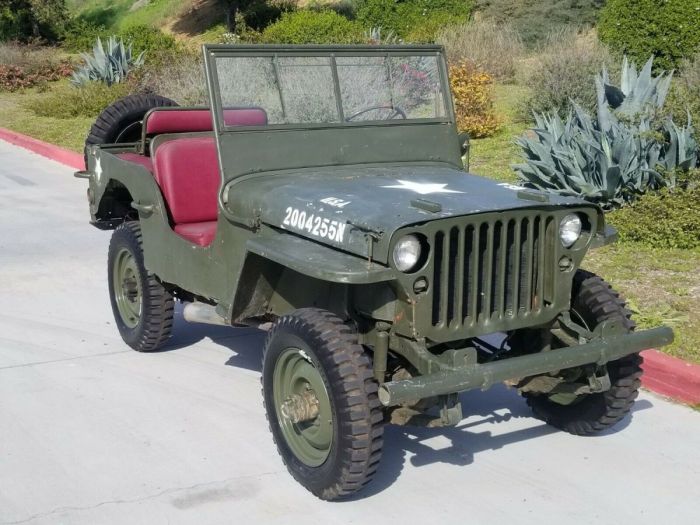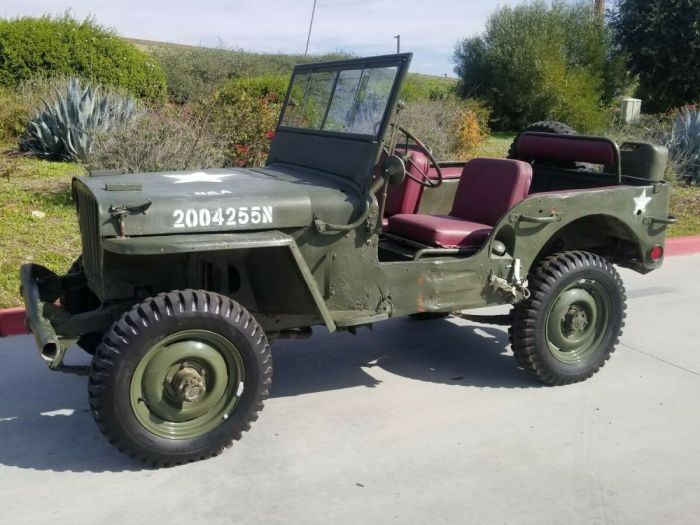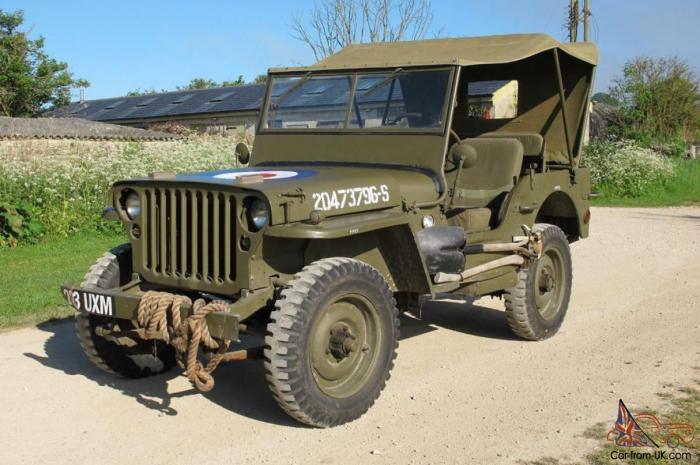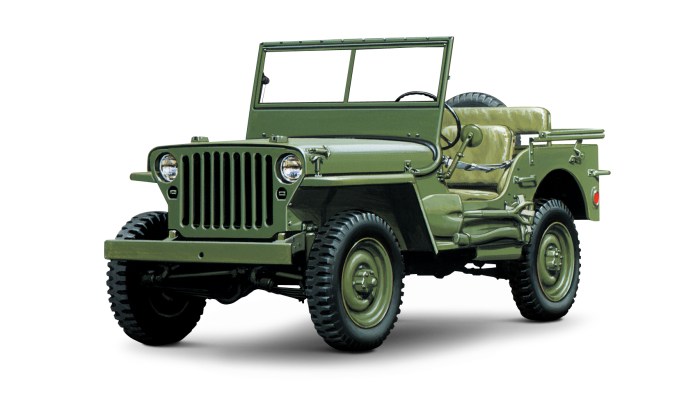The 1944 Willys Jeep is more than just a vehicle; it’s a symbol of American ingenuity and resilience during World War II. Born from the need for a rugged, versatile, and reliable machine for the battlefield, the Jeep quickly became an indispensable tool for Allied forces.
Its compact size, powerful engine, and remarkable off-road capabilities allowed it to navigate challenging terrains and perform a wide range of tasks, from transporting troops and supplies to providing reconnaissance and support in combat.
The Jeep’s impact extended far beyond its military applications. Its popularity with soldiers, combined with its durability and adaptability, led to its widespread adoption in civilian life after the war. The Jeep’s legacy continues to this day, with the iconic design inspiring generations of off-road vehicles and becoming synonymous with adventure and freedom.
Historical Context

The Willys Jeep, a four-wheel drive utility vehicle, played a pivotal role in World War II, becoming an iconic symbol of Allied victory and a testament to American ingenuity. Its versatility and reliability made it indispensable for a wide range of military operations, revolutionizing warfare and leaving a lasting impact on the automotive industry.
The Willys Jeep’s Role in Allied Victory
The Willys Jeep’s influence on the Allied victory was multifaceted. Its ability to traverse diverse terrain, from mud and snow to deserts and jungles, allowed troops to reach remote areas and establish supply lines, giving them a strategic advantage.
- Transportation:The Jeep served as a primary means of transportation for soldiers, officers, and supplies, enabling rapid deployment and efficient movement of troops across battlefields. It was particularly valuable in situations where traditional vehicles struggled, such as in mountainous terrain or dense forests.
- Recon:The Jeep’s maneuverability and compact size made it ideal for reconnaissance missions. It could easily scout enemy positions, gather intelligence, and relay information back to headquarters, providing vital insights for strategic planning.
- Logistics:The Jeep’s robust design and four-wheel drive capability allowed it to tow artillery pieces, carry ammunition, and transport wounded soldiers, ensuring the smooth flow of supplies and medical support on the battlefield.
- Communication:Jeeps were often equipped with radios, enabling communication between units and command centers, facilitating coordination and strategic planning during combat operations.
Development and Production of the Willys Jeep
The development of the Willys Jeep was a collaborative effort between the U.S. Army and several automotive manufacturers. The Army’s need for a lightweight, versatile vehicle for reconnaissance and transportation led to the creation of the “quad” (four-wheel drive) vehicle concept.
- Early Designs:In 1940, the Army issued a request for proposals for a lightweight reconnaissance vehicle. Several companies, including Bantam, Willys-Overland, and Ford, submitted prototypes. The Bantam Car Company’s “BRC” model was the first to be built, followed by Willys’s “Quad” and Ford’s “GP.”
- Willys’s Design:The Willys Quad, designed by Karl Probst, featured a simple, robust design, a powerful engine, and a four-wheel drive system. Its compact size and maneuverability made it ideal for military operations. The Army’s testing revealed the Willys Quad’s superior performance, particularly in off-road conditions.
- Production and Deployment:In 1941, the Army awarded a production contract to Willys-Overland, designating the vehicle as the “MB” (Military, Bantam). Production ramped up significantly during the war, with millions of Jeeps being manufactured by various companies, including Willys-Overland, Ford, and Kaiser-Frazer.
Technical Specifications and Design

The Willys Jeep was a marvel of engineering, designed for ruggedness, versatility, and ease of maintenance. It was a vehicle that could handle the demands of war and proved to be a crucial asset for the Allied forces.
Key Technical Specifications
The Willys Jeep’s success stemmed from its simple yet effective design. Here are some key specifications that defined its performance:
- Engine:The Jeep was powered by a 134 cubic inch, four-cylinder, L-head engine that produced 60 horsepower. The engine was known for its reliability and ability to run on a variety of fuels, making it suitable for various battlefield conditions.
- Transmission:It featured a three-speed manual transmission with a single-speed transfer case, providing a low-range gear for off-road driving. This configuration enabled the Jeep to navigate challenging terrain and provided the necessary torque for hauling cargo or towing artillery.
- Suspension:The Jeep’s suspension system was designed for ruggedness and off-road capability. It used leaf springs for both the front and rear axles, which allowed for good ground clearance and flexibility over rough terrain.
- Dimensions:The Jeep was relatively compact, measuring just 132 inches in length, 64 inches in width, and 70 inches in height. This small size made it maneuverable in tight spaces and easy to transport by air or sea.
- Weight:The Jeep’s lightweight design was a key advantage. It weighed approximately 2,400 pounds, which allowed it to be easily towed behind larger vehicles or transported by air.
Unique Design Features
The Willys Jeep was a revolutionary design for its time. It was specifically engineered to be versatile and capable of handling a wide range of tasks.
- Four-wheel drive:This feature was crucial for the Jeep’s off-road capabilities. It allowed it to navigate difficult terrain and provided superior traction in challenging conditions.
- Compact size:The Jeep’s small size was a significant advantage in combat, allowing it to maneuver in tight spaces and easily transport troops and supplies. It could also be airlifted, which was a crucial capability for rapid deployment.
- Versatility:The Jeep’s design allowed for a wide range of modifications and attachments, including machine gun mounts, trailers, and other specialized equipment. This adaptability made it suitable for various tasks, from reconnaissance to troop transport and artillery support.
- Durability:The Jeep was built to withstand harsh conditions and heavy use. It featured a simple and rugged design, with components that were easy to repair and maintain in the field.
Comparison with Other Military Vehicles
The Willys Jeep was a unique vehicle compared to other military vehicles of the time.
- Compared to trucks:While trucks were essential for transporting large quantities of supplies and personnel, they were less maneuverable and could not handle challenging terrain as well as the Jeep. The Jeep’s smaller size and four-wheel drive system made it ideal for reconnaissance and navigating rough terrain.
- Compared to tanks:Tanks were heavily armored and powerful but were much larger and less mobile than the Jeep. The Jeep’s speed and agility allowed it to scout ahead of tank units and provide support in a variety of situations.
Military Applications: 1944 Willys Jeep

The Willys Jeep, with its exceptional off-road capabilities and versatility, became an indispensable tool for the Allied forces during World War II. Its compact size, rugged construction, and adaptability made it suitable for a wide range of military tasks, revolutionizing warfare and contributing significantly to Allied victories.
Use in Different Theaters of War
The Willys Jeep was deployed in all major theaters of World War II, demonstrating its adaptability to diverse terrains and combat scenarios.
- European Theater:The Jeep was extensively used in Europe, traversing the rugged terrain of France, Italy, and Germany. It served as a reconnaissance vehicle, carrying troops and supplies, and providing vital support for infantry units. The Jeep’s maneuverability proved crucial in urban warfare, where its small size allowed it to navigate narrow streets and alleys.
The 1944 Willys Jeep was a workhorse, built tough to handle the demands of World War II. But after the war, folks wanted something a little more comfortable for everyday driving. That’s where the 1949 Willys Wagoneer came in. It took the Jeep’s ruggedness and added a bit of passenger car flair, becoming a pioneer in the SUV market.
And while the Wagoneer offered more comfort, the 1944 Jeep’s legacy of resilience continued to inspire generations of off-road vehicles.
- Pacific Theater:The Jeep’s performance in the Pacific was equally impressive. It was utilized in jungle warfare, navigating dense vegetation and carrying troops and equipment across challenging terrain. The Jeep’s reliability and resilience in harsh conditions made it a valuable asset in the Pacific campaign.
- North African Campaign:The Jeep’s off-road capabilities were put to the test in the North African desert. It proved highly effective in transporting troops and supplies across vast stretches of sand and providing vital support for armored units. Its ability to operate in extreme heat and arid conditions made it a crucial asset in the desert warfare.
Impact on Military Tactics and Strategy
The Willys Jeep had a profound impact on military tactics and strategy, influencing how wars were fought and won.
- Increased Mobility:The Jeep’s exceptional maneuverability and off-road capabilities revolutionized battlefield mobility. It allowed troops to move quickly and efficiently across diverse terrain, giving them a significant advantage over enemy forces.
- Enhanced Reconnaissance:The Jeep’s compact size and speed made it an ideal reconnaissance vehicle. It could easily scout enemy positions and gather valuable intelligence, providing vital information for commanders to make informed decisions.
- Improved Logistics:The Jeep’s ability to carry supplies and equipment over challenging terrain greatly improved battlefield logistics. It enabled the rapid delivery of ammunition, food, and medical supplies to troops on the front lines, ensuring their continued fighting capacity.
- Versatile Support:The Jeep’s versatility allowed it to be adapted for a wide range of tasks, including towing artillery pieces, transporting wounded soldiers, and providing communication support. Its adaptability made it a valuable asset for both offensive and defensive operations.
Post-War Legacy

The Willys Jeep, a symbol of American ingenuity and wartime resilience, transitioned seamlessly from the battlefield to civilian life, leaving an indelible mark on society. Its ruggedness, versatility, and affordability made it a popular choice for farmers, ranchers, and adventurers, paving the way for the modern SUV.
The Jeep Brand’s Evolution and Continued Popularity
The success of the Willys Jeep led to the establishment of the Jeep brand, which has evolved over the decades while retaining its core values of durability, off-road capability, and practicality. After the war, Willys-Overland Motors continued to produce civilian versions of the Jeep, expanding its lineup with models like the CJ-2A, CJ-3A, and CJ-5.
These early models were embraced by enthusiasts for their ruggedness and off-road prowess, becoming staples in the burgeoning off-roading community.
The 1944 Willys Jeep, a symbol of American ingenuity and wartime grit, was a far cry from its civilian predecessors. While the iconic Jeep was designed for rugged terrain and combat, its roots can be traced back to the sleek and stylish 1933 Willys Coupe.
This coupe, with its Art Deco styling and advanced features for its time, showcased Willys’ design prowess. The 1944 Jeep, though a different beast entirely, inherited that spirit of innovation, carrying it onto battlefields and into the hearts of a generation.
- The introduction of the iconic CJ-7 in 1976 further solidified the Jeep brand’s dominance in the off-road market, offering a more comfortable and refined driving experience. This model became a cultural icon, appearing in countless movies, TV shows, and video games.
- In the 1980s, Chrysler acquired the Jeep brand and introduced the Cherokee, a more car-like SUV that appealed to a wider audience. The Cherokee’s success paved the way for the introduction of the Grand Cherokee in 1992, a larger and more luxurious SUV that quickly became one of the best-selling SUVs in the world.
- Today, the Jeep brand continues to be a leader in the SUV market, offering a wide range of models, from the compact Renegade to the full-size Wagoneer. The brand’s unwavering commitment to off-road capability, coupled with its iconic design and reputation for durability, ensures its continued popularity.
Notable Examples and Stories

The Willys Jeep played a pivotal role in many significant historical events, leaving behind a legacy of resilience and adaptability. From its use in major battles to its association with iconic figures, the Jeep’s story is intertwined with some of the most defining moments of the 20th century.
Famous Individuals and Their Jeeps
The Willys Jeep became synonymous with the American war effort during World War II, and many prominent figures, both military and civilian, were associated with it.
- General Dwight D. Eisenhower, Supreme Commander of Allied Forces in Europe, famously used a Willys Jeep as his primary mode of transportation during the war. The Jeep’s versatility and ruggedness allowed Eisenhower to navigate the battlefield and inspect troops in difficult terrain.
- General George S. Patton, known for his aggressive tactics, was also a strong advocate for the Jeep. He believed that the Jeep’s maneuverability and speed gave his troops a distinct advantage in battle.
- President Franklin D. Roosevelt, who was wheelchair-bound, relied on a custom-modified Willys Jeep for transportation. The Jeep’s spacious interior and adjustable seats allowed Roosevelt to participate in important wartime conferences and events.
The Willys Jeep in Action
The Willys Jeep saw action in numerous battles and campaigns, proving its worth as a vital tool for Allied forces.
- The Battle of Normandy (D-Day):The Jeep was instrumental in the Allied invasion of Normandy, providing crucial transportation for troops, supplies, and communication equipment. The Jeep’s ability to traverse the beaches and the surrounding countryside gave Allied forces a significant advantage in the early stages of the battle.
- The Battle of the Bulge:During the German counteroffensive in the Ardennes Forest, the Jeep’s resilience and off-road capabilities allowed Allied troops to maintain communication and supply lines in harsh winter conditions.
- The Pacific Theater:The Jeep was deployed in the Pacific theater, where its ability to handle the dense jungle terrain and rugged coastlines made it a valuable asset for American forces.
Models and Unique Features, 1944 Willys Jeep
The Willys Jeep evolved over time, with different models being introduced to meet specific needs.
| Model | Year | Unique Features |
|---|---|---|
| Willys MB | 1941-1945 | Original model, featuring a 4-cylinder engine, 4-wheel drive, and a removable top. |
| Ford GPW | 1942-1945 | Ford’s version of the Willys MB, with a similar design but with minor differences in the engine and bodywork. |
| Willys CJ-2A | 1945-1949 | The first civilian model, featuring a more comfortable interior and a larger engine. |
| Willys CJ-3A | 1949-1953 | A further refinement of the CJ-2A, with improved suspension and a more durable body. |
Last Point

The 1944 Willys Jeep stands as a testament to the power of innovation and the enduring impact of a truly remarkable design. From its humble beginnings as a wartime necessity, the Jeep has evolved into a cultural icon, representing ruggedness, versatility, and the spirit of adventure.
Its influence on military tactics, automotive design, and popular culture is undeniable, ensuring that the legacy of the 1944 Willys Jeep will continue to inspire for generations to come.